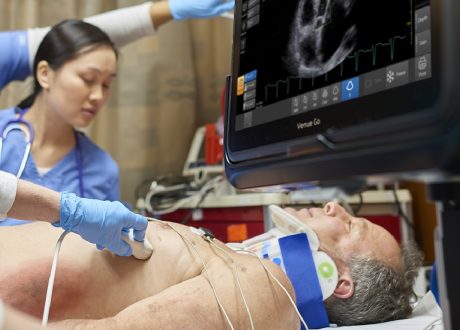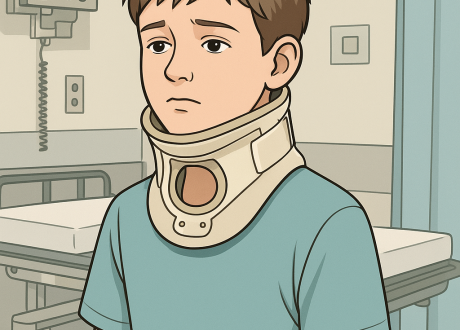Podcast: Play in new window | Download
“This learning material is sourced from Emergency Medicine Cases and has been published here with permission as per creative commons copyright”
In this EM Cases main episode podcast with Dr. Shannon MacPhee and Dr. Jeanette Comeau we discuss the recognition, risk stratification, decision tools, indications for lumbar puncture in the febrile pediatric patient, tips and trick on performing LPs in children, and ED management of pediatric meningitis including antibiotic choices and dexamethasone. We answer such questions as: what are the test characteristics of the various clinical features of meningitis across various ages? How does one differentiate between meningitis and retropharyngeal abscess on physical exam? How do the Canadian and American guidelines on work up of well-appearing febrile infants compare when to it comes to indications for lumbar puncture? Which patients with suspected meningitis require imaging prior to lumbar puncture? Which patients with febrile seizure require a workup for meningitis? How do we best interpret the various CSF tests to help distinguish between viral and bacterial meningitis? What are the indications and timing of administering dexamethasone in the pediatric patient with suspected meningitis? and many more….
Podcast production, sound design & editing by Anton Helman; Voice editing by Braedon Paul
Written Summary and blog post by Matthew McArthur, edited by Anton Helman July, 2024
Cite this podcast as: Helman, A. Comeau, J. MacPhee, S. Pediatric Meningitis Recognition, Workup and Management. Emergency Medicine Cases. July, 2024. https://emergencymedicinecases.com/pediatric-meningitis-recognition-workup-management. Accessed July 20, 2024
While pediatric bacterial meningitis is rare, it is predicted to be on the rise due to decreasing vaccination use
Thanks in large part to vaccination programs, meningitis is a rare diagnosis. Its rarity and potential serious sequelae if untreated make it challenging but important to recognize when it occurs. The estimated incidence of bacterial meningitis is only 0.4/100,000 in adolescents but increases to 81/100,000 in neonates with a mortality rate of 20% in infants and 2% in older children. Most pediatric meningitis is caused by an enterovirus. The earlier the diagnosis of bacterial meningitis is made and the sooner treatment is initiated, the better the outcomes. One of the reasons we chose this topic is because there is a trend of decreasing use of childhood vaccinations in the last decade, which experts predict is likely to increase the rates of meningitis from vaccine preventable pathogens including Hemophilus Influenzae, Streptococcus Pneumoniae, Neisseria Meningiditis in the coming years.
Understanding the pathophysiology of and knowing the risk factors for bacterial meningitis helps guide recognition and management
Sequence of steps leading to bacterial meningitis:
- Bacterial colonization (most often respiratory tract/oropharynx – bacterial meningitis may be preceded by a viral infection which increase the likelihood of bacterial colonization)
- Invasion of bloodstream (risk factors to consider in the pre-test probability of bacterial meningitis include: recent viral illness, smoking history, alcohol use disorder, immune suppression/immune deficiency, no or incomplete vaccinations against S pneumoniae, N meningitides, H influenza)
- Survive intravascularly and interact with BBB to penetrate into subarachnoid space (main risk factors are duration and degree of bacteremia, antibiotics that penetrate the BBB are required – see below)
- Relative lack of immunity within CSF space, bacterial proliferation and immune/inflammatory response (dexamethasone for inflammation – see below)
Common bacterial causes of pediatric meningitis are based on the most likely oropharyngeal colonizers:
Neonates: Group B Strep, E Coli
Older Children: S pneumoniae, N Meningitides
Pitfall: Meningitis can sometimes result from contiguous or hematogenous spread from a primary infection such as sinusitis or acute otitis media. Don’t prematurely rule out meningitis in a sick patient after making a primary diagnosis like sinusitis. Have a heightened index of suspicion in patients who had initial RTI symptoms with a “second worsening”.
Clinical features and their test characteristics in pediatric meningitis
The history and physical exam findings are less specific and more subtle the younger the patient is and in those taking antibiotics and/or steroids as well as in immunocompromised patients.
Clinical features of meningitis in infants <90 days old
- Meningitis tends to present with very nonspecific and sometimes subtle findings in neonates and very young infants
- A common presenting complaint is simply “not feeding well” and this should be taken seriously and explored
- Classic symptoms in this age group include lethargy, irritability, and seizure(s)
- Irritability that increases when in parent’s arms/decreases when lying motionless
- High pitched / abnormal cry
- Fever or hypothermia (>38C or <36C)
- Bulging Fontanelle *performed with infant sitting or held upright
- Nuchal rigidity of usually absent in infants with meningitis
Pearl: Infants with meningitis tend to have a paradoxical increase in irritability when they are held in parent’s arms and usually prefer lying motionless on the stretcher.
Pitfall: A common pitfall is assessing for a bulging fontanelle while the infant is lying supine. This assessment should be performed with the infant in an upright position.
Clinical features of meningitis in older children
- Older children are more likely to have localizing symptoms and signs to the CNS
- Nonetheless, the classic triad of fever, headache, neck stiffness, is only present in 50% of patients
- Spreading petechial rash is highly suggestive of bacterial meningitis
- Meningeal signs have poor accuracy:
- Nuchal rigidity – Sens 51-65%, Spec 54-89%
- Kernig’s – Sens 27-53%, Spec 74-95%
- Brudzinski – Sens 51-66%, Spec 74-80%
- Jolt accentuation of headache – Sens 65% Spec 70%
Pitfall: Don’t rely on any one of the meningeal signs to rule out meningitis, as they all have poor sensitivities; the younger the patient, the less likely meningeal signs are present. Even jolt accentuation of headache, which previously was thought to be an accurate predictor of meningitis, has recently been shown to have a sensitivity of only 65% and a specificity of 70%.
Pearl: Neck stiffness can also be caused by retropharyngeal abscess – but in patients with retropharyngeal abscess pain is typically exacerbated by neck extension whereas in meningitis flexion typically makes it worse
Pearl: children taking antibiotics or steroids may have more subtle clinical findings of meningitis
Workup and risk stratification for febrile infants < 60 days who are otherwise well appearing
Because of the highly nonspecific clinical findings of meningitis and other invasive bacterial infections (IBIs) in neonates and very young infants, and that newborns with IBI can deteriorate rapidly, objective risk stratification tools are recommended to guide workup and admission decisions for febrile infants < 60 days old.
Risk stratification tools use inflammatory markers (neutrophil count, CRP, procalcitonin), urinalysis, and clinical findings. Three common tools are the Step-by-step, PECARN, and Aronson rule, all of which have >99% negative predictive value for ruling out IBI and meningitis.
The choice of which decision tool one uses depends on local availability of procalcitonin.
Step-by-Step Febrile Infant Decision Tool
- Well appearing
- 22-90 days old
- Urinalysis negative for leukocytes
- Procalcitonin <0.5ng/mL
- CRP ≤20mg/L and ANC ≤10,000/µL
All criteria met = low risk = 0.7% risk of IBI – full septic workup likely not required; consider observation in ED and ensure close outpatient follow up
PECARN Febrile Infant Decision Tool
- Urinalysis negative for leukocyte esterase, nitrites and pyuria (WBC ≤5/hpf)
- ANC ≤4090/µL
- Procalcitonin ≤1.7ng/mL
The PECARN rule low risk febrile infants 26-60 days of age has a 99.8% sensitivity for serious bacterial infection.
Aronson Febrile Infant Decision Tool (when procalcitonin is not available)
- Age <21 days (1 point)
- Highest temperature measured in the ED
- 38.0-38.4 ℃ (2 points)
- ≥38.5 ℃ (4 points)
- ANC ≥5185/µL
- Urinalysis positive (leucocyte esterase, nitrites or pyuria (>5WBC/hpf 3 points)
“A score <2 can be used to identify infants with a history of fever only, who have a low probability of having an IBI, and who may not require CSF testing.”
Deep dive into Risk Stratification and Workup of Febrile Infant EMCases Episode 174 with an algorithm consistent with the 2023 Canadian Pediatrics Society Guideline.
Comparison of Canadian and American Guidelines for well appearing febrile infants <60 days with regards to indications for lumbar puncture and meningitis considerations

Which patients with febrile seizure should be considered for a lumbar puncture?
Patients with simple febrile seizures generally do not require a lumbar puncture to screen for meningitis. It is clear in the literature that children who have suffered a simple febrile seizure are at no greater risk for serious bacterial infection than age-matched controls who have not seized. However, about 25 % of children with meningitis will present with a new onset febrile seizure, and they will almost always display persistent mental status abnormalities along with other signs of meningitis. Patients with complex febrile seizures may require a lumbar puncture if their level of awareness does not return to baseline. A retrospective study in 2018 including over 28,000 patients (ages 0-5) with complex febrile seizures showed a very low incidence of meningitis, suggesting lumbar punctures are low-yield in this population. Caution was warranted in those who were unvaccinated, pre-treated with antibiotics or had suspicious symptoms/signs of meningitis.The decision to perform an LP in patients with complex febrile seizures is nuanced and should be individualized with this data in mind. Consultation with pediatrics is recommended.
Indications for neuroimaging before LP in the workup of pediatric meningitis and the timing of antibiotic administration
The vast majority of pediatric patients with meningitis do not require neuroimaging. The priority is administering appropriate antibiotics ASAP. While CSF may become sterile in as little as one hour after IV antibiotic administration in some patients (depending on the organism), antibiotic administration should not be delayed for imaging or LP in the patient with a high pretest probability for bacterial meningitis. Ideally, antibiotics should be given and the LP performed at the same time as soon as the diagnosis of meningitis is entertained. It is reasonable to delay antibiotic administration until after the LP is completed in patients with a low clinical pretest probability for bacterial meningitis.
Indications for neuroimaging in pediatric meningitis
Most patients with meningitis do not require neuroimaging. There are two indications for neuroimaging in pediatric patients with suspected meningitis:
- Suspected space occupying lesion (eg focal seizure, focal neuro deficit, immunodeficiency, persistently low LOC)
- Clinical concern for raised ICP (eg Cushing’s triad, diplopia, abnormal pupillary responses, decerebrate or decorticate posture, low HR + elevated BP + irregular respirations, papilledema)
Absolute contraindications to LP in the pediatric patient
- GCS <8 or deteriorating/fluctuating level of consciousness
- Signs of raised intracranial pressure (ICP): diplopia, abnormal pupillary responses, decerebrate or decorticate posture, low HR + elevated BP + irregular respirations, papilledema
- Coagulopathy
- Known spinal cord lesion
A bulging fontanelle or space occupying lesion in the absence of other signs of raised ICP is not an absolute contraindication to LP.
Lumbar puncture tricks and tips in the pediatric population
- Have an honest up-front conversation with family – explain that the LP is a challenging procedure, may not always be successful (success rates have been reported to be about 60%)
- Keep infant pain free
- Apply topical anesthetic (amitop, maxilene) if time permits
- Infiltrate local anesthetic 1-3mLs lidocaine
- Sucrose
- For older children and teenagers consider procedural sedation
- Sitting position tends to have higher success rate compared to lateral decubitus position (see image)
- Recent RCT in neonates showed success rates for obtaining CSF: Sitting 64%, Lateral 57%
- Flex hips and flex lumbar spine, to open up space between spinous processes, avoid neck flexion as this may cause respiratory depression
- Landmarking – aim L4-L5 in neonate (lower than L3-L4 in adults)

Source: Plaza-Verduin, M.A., Lucas, J.K. (2016). Lumbar Puncture in Pediatrics. In: Ganti, L. (eds) Atlas of Emergency Medicine Procedures. Springer, New York, NY.
CSF tests and interpretation in suspected pediatric meningitis
Practical tip: Whenever possible obtain 3-4mL additional CSF in the last tube that can be sent for additional microbial testing at a later date, if needed.
| Test | Interpretation | Considerations |
| Cell Counts |
|
|
| Gram Stain and Culture |
|
|
| Molecular testing (PCR) |
|
|
| Chemistry (Glucose, Protein, Lactate) |
|
|
Pitfall: A common pitfall is ruling out bacterial meningitis based on a low WBC alone; while a WBC < 30 in a neonate and <5 in older children is less likely in bacterial meningitis, the diagnosis cannot be ruled out on this test alone.
When to consider HSV encephalitis and Lyme meningitis
HSV encephalitis
- In pediatrics, usually occurs in the first month of life, up to 6 weeks of age
- Index of suspicion increased based on risk factors
- Primary HSV infection around parturition is greatest risk factor
- Maternal genital lesions
- Seizure in neonate
- Obtain molecular CSF testing for HSV if suspicion; consider empiric treatment with acyclovir
Lyme meningitis / encephalitis
- Lyme meningitis/encephalitis is distinctly uncommon
- Generally, the clinical course of lyme meningitis is indolent compared to other bacterial meningitides
- In children, Lyme meningitis is rare if headache duration < 7 days, CSF mononuclear cell <70% and there is no 7th or other cranial nerve palsy. The ECG may reveal an AV block. Brain imaging may show punctate lesions of the periventricular white matter.
- For patients in Lyme endemic areas and an indolent onset of illness or other clinical evidence of Lyme disease (eg annular rash), Lyme serology and CSF Lyme testing is indicated, although there is thought to be a high rate of false negatives
- Empiric ceftriaxone for meningitis covers Lyme
Treatment of suspected pediatric meningitis
Antibiotic choices in pediatric meningitis
Broad spectrum empiric antibiotics ASAP are indicated for patients suspected of meningitis, regardless of whether the suspicion is for viral or bacterial meningitis. Viral meningitis should be considered a diagnosis of exclusion. Choice of antibiotic regimen depends on age and is listed below.

Source: TREKK meningitis bottom line recommendations https://cms.trekk.ca/wp-content/uploads/2023/11/2023-09-07_Meningitis-BLR_FINAL-.pdf
Indications and timing of dexamethasone in pediatric meningitis
Dexamethasone is generally not recommended for neonatal meningitis (<30 days of life). There is evidence for improved outcomes in patients with Strep pneumo and H Influenzae meningitis. If given, it should be given early – within the first 4 hours. However some guidelines recommend waiting for initial gram stain to suspect S pneumo or H flu before administration.










